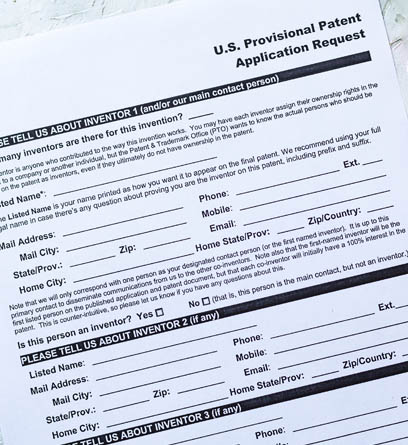WHAT IS A PROVISIONAL PATENT APPLICATION?
A provisional patent application is a patent application filed to establish an early effective filing date for a future non-provisional patent application; in other words—it is a cost-effective place holder.
REASONS FOR FILIING A PROVISIONAL PATENT APPLICATION
A provisional patent application is not examined, and a provisional patent application cannot result in an issued patent. Yet, there are several reasons why an inventor might file a provisional patent application instead of a non-provisional patent application:
- The inventor needs more time to finish additional experiments or to flush out the final details of their invention before filing a non-provisional application
- The inventor has an urgent upcoming meeting that will require the disclosure of their invention to an investor or to the interested public at a convention or trade show
- The inventor is facing an upcoming on-sale bar date, which occurs when a product is first sold prior to the filing of a patent application. A patent application must be filed less than one year after the sale of a product, a term sometimes referred to as a grace period
- The inventor does not yet have the money to pay for a non-provisional application, so the extra time provided by a provisional application can be used to acquire investors
- The inventor is allowed to mark their product with the term “Patent Pending,” which provides competitors with notice of the inventor’s potential future IP rights.


PENDENCY OF A PROVISIONAL
PATENT APPLICATION
A provisional patent application, filed under 35 U.S.C. § 111(b), expires one year from its filing date. The 12-month pendency period cannot be extended. Inventors therefore have up to a year to convert the provisional application into a non-provisional patent application (i.e., a typical patent application filed under 35 U.S.C. § 111(a)).
CONTENT OF A PROVISIONAL PATENT APPLICATION
To be accepted in the U.S. Patent Office, a provisional patent application must include: (i) a cover sheet listing the names of each inventor, the title of the invention, and other identifying information; (ii) a description of the invention; (iii) any drawings necessary to understand the invention; and (iv) the appropriate filing fee.
A provisional patent application does not require claims, professional drawings, a background section, and other formalities required for a non-provisional application, including an inventor oath/declaration and an information disclosure statement (IDS).
For the reasons further explained below, the objective when drafting a provisional patent application is to describe the invention as best as possible.
OLD SCHOOL VS. NEW SCHOOL
The U.S. Patent Office began offering the option of filing a provisional patent application in 1995 to provide a lower-cost first patent filing in the United States and to give U.S. inventors parity with foreign applicants under the GATT Uruguay Round Agreements. At the time, and any time up to the effective date of the Leahy-Smith America Invents Act (AIA), patent practitioners were not necessarily concerned with the quality of a provisional patent application because the IP rights associated with an invention could be based on the date of invention if needed. For example, if two independent inventors created the same invention at around the same time, the patent would be awarded to the inventor who could prove the earliest date of invention. Thus, the quality of the provisional application was not as critical in the era before the AIA because an inventor could establish with laboratory notebooks and other evidence when the invention occurred and essentially supplement the record with such evidence.
The AIA significantly changed the law. IP rights in the U.S. are now based on who filed their patent application first. Accordingly, since March 16, 2013, if two independent inventors created the same invention at around the same time, the patent would be awarded to the inventor who was first to file their application with the Patent Office. One must look to the earliest effective filing date to determine who was first to file, and that date can be based on a provisional patent application or a non-provisional patent application. Laboratory notebooks and other evidence are no longer relied on to prove the date of invention, or to explain how to make and use the invention.
QUALITY PROVISIONAL PATENT APPLICATIONS ARE REQUIRED
A patent application must disclose how to make and use the disclosed invention, a concept referred to as “enablement.” A patent practitioner can no longer quickly slap together a non-enabling provisional patent application for an inventor and subsequently rely on laboratory notebooks or other evidence to show how to make and use the invention. Instead, the description of the invention in the patent application itself must be sufficient to show how to make and use the invention. A patent practitioner must focus on quality when drafting a provisional patent application because a non-enabling provisional application may not be sufficient to establish a winning “earliest effective filing date.”